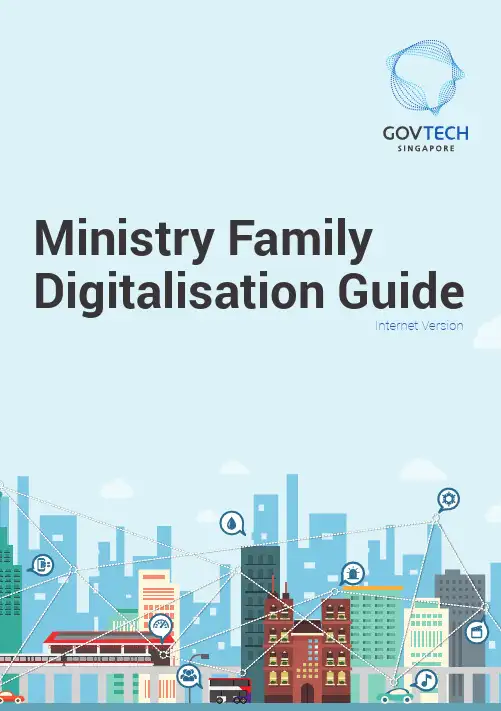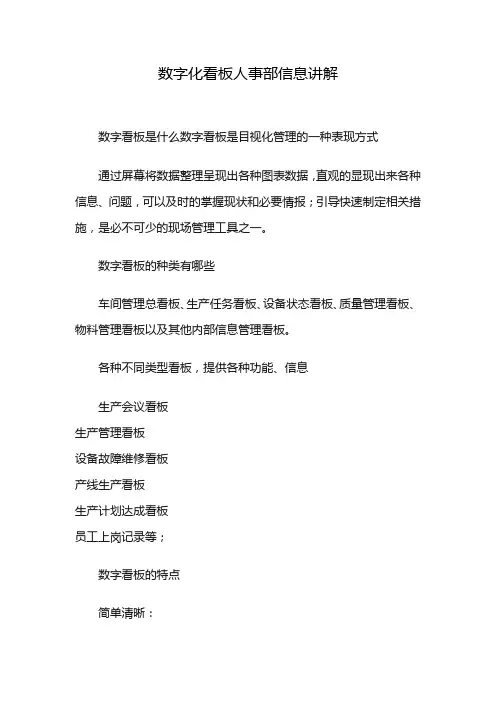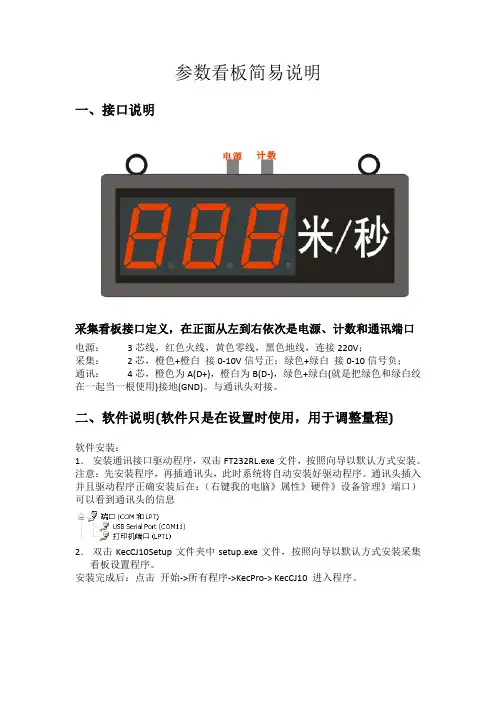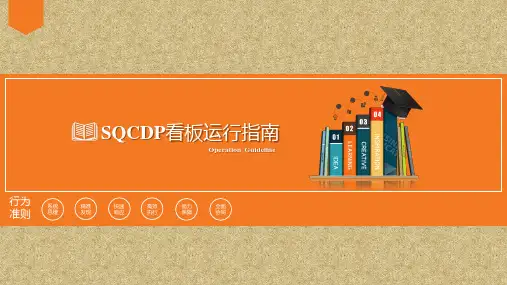数字化看板编制说明
数字化指南说明书

Ministry Family Digitalisation GuideInternet VersionTABLE OF CONTENTSCopyright of GovTech Not to be reproduced unless with explicit consent by GovTech 020622About the Ministry Family Digitalisation GuideThis handbook comprises suggested approach, key principles and other reference resources that will serve as a guide to Ministry Family Chief Digital Strategy Officers (CDSOs) andrelevant officers involved in developing digitalisation plans for their agencies.This version is adapted from the guide given to Chief Digital Strategy Officers for formulating their Ministry Family Digitalisation Plans.Copyright © 2018 by GovTech. Not to be reproduced unless with explicit consent by GovTech.First released in March 2018.011.0WHAT IS DIGITALISATION?02Digitalisation and the impetus for a digitalisation planBUSINESS MODEL CHANGESDIGITAL TECHNOLOGIESDIGITALTRANSFORMATIONWHAT IS DIGITALISATION?DIGITAL DISRUPTION IS ALL AROUND US04Automobile HealthcareMedia Services Government Services Hospitality Retail TransportationWHY DIGITALISATION IS IMPORTANTGovernment needs to transformAt Individual...At Agency...At WOG...level0506Key principles for digitalisation…a set of principles to leverage digital technologies to transform the way we think, work and serve citizens & businesses…2.0DIGITAL PRINCIPLESHOW TO DESIGN HOW TO MANAGE CHANGE 2.1OVERALL FRAMEWORKPRINCIPLE 01Think simplePRINCIPLE 03Co-develop & co-deliver with citizensPRINCIPLE 05Collect, share & use data PRINCIPLE 07Foster a digital DNAPRINCIPLE 02Be agile & iterate PRINCIPLE 06Use govt tech stack to expedite deliveryPRINCIPLE 04Partner external organisations PRINCIPLE 08Integrate ops & tech PRINCIPLE 09Manage change & drive adoption07• Examine if your organisation’s business, operating models and service delivery are still relevant and if they might be disrupted by digital technologies.• Determine how digitalisation can help optimise internal operations or public service transformation.• Aligned to business goals, set clear digital strategies to address impact on organisational design, processes, business model and personnel.BEFORE YOU START…Ask why the need to transformFOCUSSimplify services and streamline processes to serve citizenseffectively. Organisations need to review all the processes and interfaces to identify areas that can be simplified.Simplicity is not simple – itrequires good judgement of what really matters, and a bold decision to focus on them. Resist the temptation and old belief ofneeding to be “comprehensive,” as it does not enhance user experience.Think simple01PRINCIPLECase study : Parking.sg• Without complex IoT sensors, URA & HDB implemented mobile app for parking within a few months.to get to the final implementation. New features will be prioritised and progressively added in each iteration.Being agile will require userexecutives to be fully involved in the design and development process along with tech developers.PRINCIPLECase study : MOM FDW• MOM implemented Foreign Domestic Worker’s work pass system with multiple releases over 12 months, with a Minimum Viable Product (MVP) within 9 months.PRINCIPLEPRINCIPLEconnection to external organisations.Government can own such digitalplatforms or connect to platformsoperated by other organisations. Case study: National Trade Platform• Through the National TradePlatform, Government partnersthe private sector to develop andoffer services to the trade andlogistics community.PRINCIPLE06PRINCIPLESimilarly, reuse WOG standard products and solutions without having to re-invent the wheel.Case study : Business Grants Portal • Business Grants Portal leveraged Government Tech Stack to shorten delivery timePRINCIPLEPRINCIPLE08PRINCIPLE 09Steps and deliverables in developing the Ministry Family Digitalisation Plan3.0Developing Ministry Family Digitalisation PlanCONSIDERATIONMinistry family will take into account these drivers to align the Ministry Family Digitalisation Plan.*The Digital Government Blueprint aims to set out strategies to guide agencies on transforming to be a digital government.DRIVERS FOR MINISTRY FAMILY DIGITALISATION PLANMINISTRY FAMIL Y DIGITALISATION PLANKEY COMPONENTS OF MINISTRY FAMILY DIGITALISATION PLANS (MFDP)Key PhasesKey ActivitiesOutputSet of priority areas / business strategies, focusing on specific problem statementsSet of digital initiatives toachieve the desiredoutcomes in the to-be state Gap analysis of the current& to-be state withidentified opportunitiesDetermine the level of aspirations (or degree of transformation) for the focus areas in the to-be state (where you want to be) of the priority areas / business strategies.C onsider how best to adopt the digital government strategies in DGB.Define how success looks like01 DEFINE PROBLEMS02 TO-BE STATE03 DIGITAL INITIATIVESPut the citizen in the centre. Design the services for them, not around organisational limits or constraints.Transform the way we serve citizensWhat is the vision of a future citizenexperience for your service?01 DEFINE PROBLEMS02 TO-BE STATE03 DIGITAL INITIATIVESCitizens andbusinesses are invited to provide ideas on challenge statements provided by the Government.Citizens andbusinesses are invited to jointly create solutions together. They form part of the development team to build the solutions.Citizens andbusinesses are directly involved as part of the service delivery back to the same community that they belong.The level of empowerment and involvement given to citizens and businesseswill increase their shared responsibility and ownership of the solution.Involve citizens and businesses to shape ideas, co-create solutions and share responsibilities in delivering better public services to the citizens.Transform the way we engage the communityWhat is the future state of a community engagement model?01 DEFINE PROBLEMS02 TO-BE STATE03 DIGITAL INITIATIVESWhile there is an increase in back-end complexity in today’s highly connected world, front-end services are expected to become increasingly simple and user-friendly.There is a need to distil simplicity fromcomplexity. It means dividing complex processes into smaller packages and consistently plan and implement theFormulating digital initiativeslatter in an agile way. To do that,organisations must first be aware of what the end-to-end process entails, who are the parties involved, what are theinterfaces affected etc. to examine how the processes can be simplified. Fewer processes equal more speed.EMPATHISEDEFINEPROTOTYPEIDEATETESTDevelop a deep understandingof the challengeBrainstorm potential solutions; select and develop solutionClearly articulate the problem to solveDesign a series of prototypes to test all or part of the solutionEngage in continuous short-cycle innovation to improve the product• Adopt an Empathetic , Outside-In , Design thinking and Prototyping-led approach to find solutions to the problems • Study data related to user behaviour to understand their interactions and preferences01 DEFINE PROBLEMS02 TO-BE STATE03 DIGITAL INITIATIVESCitizens and businesses’ demands are fast evolving. Organisations need to find simple solutions to complex problems. Be agile in order to respond to dynamic changes for their needs.Start small on new service(s), be it starting with a small group of trialusers, or releasing only a minimum viable product (MVP). Gather users’ feedback, and make improvements. Learn what works and what doesn’t. Citizens’ needs may change.Reiterate the process to release new features or services, focusing on what citizens need.NOTE : This process will require business users to be greatly involvedand committed in the design process.Agencies can also adopt agile software development methodologies based on iterative and incremental development to develop their solutions, such as SCRUM.D ES I G N B U I L DT ES TR E V I E W P L A N LAUNCHD ES I G N B U I L DT ES TR E V I E W P L A N LAUNCHD ES I G N B U I L DT ES TR E V I E W P L A N LAUNCHSPRINT 1SPRINT 2SPRINT 3Formulating digital initiatives01 DEFINE PROBLEMS02 TO-BE STATE03 DIGITAL INITIATIVESFormulating digital initiativesInvite citizens and businesses to provide innovative ideas on how to tackle some of the challenges faced.E.g. eCitizens Ideas! crowdsourcing portal, IRAS Hackathon 2016Let the citizens andbusinesses accessyour data and sourcecodes where possible.Allow them to leverageyour APIs andmicro-services to buildamazing applicationswith them.E.g. .sg,MyInfo API, Beelinesource codes, L TADataMallOffer opportunitieswhere citizens andbusinesses canvolunteer or bemobilised to be part ofthe service delivery.Digital technologies helpbring ease in co-optingcitizens and businesses.E.g. MyResponder,OneService, MOMSnapSAFE, SGSecureIncreasing degree of community involvementCO-IDEATE CO-DEVELOP CO-DELIVEROpen InnovationOpen Data,Open Source CodeOpen Volunteerism &MobilisationIn leveraging the citizens to find solutions, Government must embrace the idea of being "Open". Digital technologies such as API, Open source code repository, micro-services and mobile helps to open up such collaboration opportunities with citizens.01 DEFINE PROBLEMS02 TO-BE STATE03 DIGITAL INITIATIVES• Digital platforms allow different actors to come together and deliver public services in new ways as well as create value for all parties• Government can be the owner of digital platforms or a participant in platforms operated by other organisations• Commercial Service Providers can collaborate with Government through the platforms to offer their services• The platforms can also be opened to Developers to develop complementary products and services• Main elements of these platforms are API management, control and securityFormulating digital initiativesDIGITAL PLATFORMSSERVICESCITIZENSBUSINESSES01 DEFINE PROBLEMS02 TO-BE STATE03 DIGITAL INITIATIVES• Public • PrivateExample:Contract manufacturers and parts suppliersExample:Amazon Web ServicesExample:App Stores Example:AirBnB38Formulating digital initiativesKey Considerations for participating in or creatingDigital PlatformsBusiness ModelsENABLEP ARTNERS IN THE SAME VALUE CHAIN TO WORK TOGETHER INTEGRATE ENABLERS TO DEVELOP NEW SERVICESDEVELOP AND PUBLISH NEW PRODUCTS AND SERVICESMATCH DEMAND AND SUPPL YDesign ConsiderationsHOW OPEN IS THE PLATFORM?WHAT IS IN IT FOR THE MEMBERS?WHO ARE THE MEMBERS?WHAT ARE THE RELATIONSHIPSAMONG MEMBERS?01 DEFINE PROBLEMS02 TO-BE STATE03 DIGITAL INITIATIVES• Citizen • Businesses • Things • Customers • Partners• Service providers• Monetary • Data • Services39Collecting the right data from internal and external sources can expand our data analytics possibilities. New data sources, from Internet-of-Things (IoT) and web analytics, are waiting to be tapped on.Building a culture of sharingmeaningful data with other agencies in the Government will encourage collaboration and improve the overall quality of data collection.Formulating digital initiativesUse insights from data analytics to derive meaningful outcomesand deliver actions from the data collected.COLLECT ORGANISEANAL YSEUSErelevant data from various sources no matter where they are data at the appropriate juncture to gain insightsinsights & data at the most logical point when decision or actions have to be madedata into appropriate stores to clean, prepareand model themfor analytics later01 DEFINE PROBLEMS02 TO-BE STATE03 DIGITAL INITIATIVES40Besides human-centric rule-based data analytics, advanced analytics with Internet-of-Things (IoT) and Artificial Intelligence (AI) can be used to obtain deep actionable insights and automate decisions in service delivery and operations.Coupled with the use of geospatial data and video analytics, the potential of richer applications with the ability to transform processes and operations can be made possible.Formulating digital initiativesEXAMPLESInfrastructure & facilities managementJTC’s integrated smart estate and building operations system, J-Ops, uses existingsensors to centrally monitor and analyse essential services and in several buildings. This raises productivity as facility managers can optimise ops room personnel and technicians over several buildings and facilities. J-Ops enables data analytics for predictive maintenance to pre-empt issues and reduce energy consumption.Urban planningURA is collaborating with A*STAR I2R and relevant planning agencies to research the use of GIS modelling, analytics and visualisation for planning of land uses, infrastructure and utilities, as well as facilities.01 DEFINE PROBLEMS02 TO-BE STATE03 DIGITAL INITIATIVES42To succeed, change must cut deep into an organisation. An effective digitaltransformation strategy needs to permeate the entire organisation to break down organisational silos and hierarchies to facilitate cross-departmental and external collaboration.Values such as agility, boldness, innovation and collaboration should be encouraged as part of the organisation culture.3.4OTHER CRITICAL FACTORS FOR A SUCCESSFUL TRANSFORMATIONGetting people ready for the changeTop leadership must be involved in the planning and implementation of digital initiatives by taking charge of decision-making. Ensure priorities are emphasised through frequent communication and see through theimplementation to ensure success. Top leadership should also be aware of digital technologies and trends, and theopportunities they create.It is critical to develop your staff for the necessary know-how to embrace digitalisation as part of their work, and build up the digital capability of the organisation.The staff can then apply these skillsets on improving business processes and service delivery.The organisational culture shouldencourage ideas and experiments on digital transformation to celebrate success and learn from failure. Innovation andrisk-taking should be rewarded.LeadershipStaff DevelopmentInnovative & Risk-taking CultureGetting people ready for the change• Integration ofOps-Tech requires close alignment of planning and strategy development instead of discrete planning exercises by both sides.• Ops-Tech integration needs to start from the early stages of conceptualisation of digital initiatives.• Ops-Tech integrationcan enable newbusiness models bybringing togetheroperationalconsiderationsenabled withpossibilities of newtechnologies.• Digitalisation initiativesshould be jointlymanaged, executedand owned by bothOps and Tech teams.• There should be aconscientious effort todevelop the staff withOps-Tech bridgingcapabilities.JOINT PLANNING AND STRATEGY DEVELOPMENT ENABLE NEWBUSINESSMODELSJOINTPROJECTOWNERSHIPTechnological developments need to be aligned to operational considerations.Integration of Ops-Tech has to occur at multiple levels of the organisation.43Getting people ready for the changeWith new products and services driven by digital transformation, the Government has to ensure that citizens will embrace these changes and adopt them.While techniques such as design thinking and agile methodology will address the issue of usability, we still need to ensure there is actual adoption. Agencies should use Change Management techniques like behavioural insights, personas identification and demographic segmentation to plan for change interventions to drive adoption.Within the organisation, staff must also make adjustment to support the new ways of delivering the digital products and services.Marketing campaigns andpublic communications Products and servicesmade readily availablethrough convenientchannelsNudging users towardsadoptionChange interventions to go from Awareness to Adoption AWARE AVAILABLE ADOPT44Mapletree Business City,Singapore 117438.sg。
数字化工作说明演示共29页

36、如果我们国家的法律中只有某种 神灵, 而不是 殚精竭 虑将神 灵揉进 宪法, 总体上 来说, 法律就 会更好 。—— 马克·吐 温 37、纲纪废弃之日,便是暴政兴起之 时。— —威·皮 物特
38、若是没有公众舆论的支持,法律 是丝毫 没有力 量的。 ——菲 力普斯 39、一个判例造出另一个判例,它们 迅速累 聚,进 而变成 法律。 ——朱 尼厄斯
40、人类法律,事物有规律使享受加强。 ——德 谟克利 特 67、今天应做的事没有做,明天再早也 是耽误 了。——裴斯 泰洛齐 68、决定一个人的一生,以及整个命运 的,只 是一瞬 之间。 ——歌 德 69、懒人无法享受休息之乐。——拉布 克 70、浪费时间是一桩大罪过。——卢梭
数字化看板人事部信息讲解

数字化看板人事部信息讲解数字看板是什么数字看板是目视化管理的一种表现方式通过屏幕将数据整理呈现出各种图表数据,直观的显现出来各种信息、问题,可以及时的掌握现状和必要情报;引导快速制定相关措施,是必不可少的现场管理工具之一。
数字看板的种类有哪些车间管理总看板、生产任务看板、设备状态看板、质量管理看板、物料管理看板以及其他内部信息管理看板。
各种不同类型看板,提供各种功能、信息生产会议看板生产管理看板设备故障维修看板产线生产看板生产计划达成看板员工上岗记录等;数字看板的特点简单清晰:在众多企业中,车间现场普遍存在着无法清晰采集需求数据,需要通过人工查询数据、寻找数据等问题,数字看板可以为企业排忧解难,能够将生产过程当中的关键数据及时、准确地呈现出来,通过应用数字看板,能够让工厂内所有人员都可以清晰阅览各项关注数据,从而大大地提高生产效率。
需求定制:基于不同的企业项目,不同类型的企业关注的数据类型也会不一样,数字看板采用多级化工艺管理,可按单、按批、按件进行工艺线路设置,满足企业复杂多样的工艺要求;数据监控:传统的制造企业都无法及时获取生产现场的异常数据,导致生产异常情况时常出现,利用数字看板可以及时的集中观察车间生产、检验、物料情况等信息,对异常状况及时预警。
快速传递:根据实施多个数字工厂项目的经验,数据无法及时的传递是所有传统制造型企业的普通痛点,通过数字看板可实现各种生产信息的快速传递,防止异常数据的决策滞后等突发情况。
数字看板的好处有哪些数据实时监控,提升产能杜绝浪费实时监控订单及人员状态,提高工作效率,节约成本; 产线生产的具体情况进行实时监控,实时发现问题和浪费;基于不同的企业项目,为不同类型的企业关注的数据定制;集中观察车间生产、检验、物料情况等信息,对异常状况及时预警;实现各种生产信息的快速传递,防止异常数据的决策滞后。
自制电子看板参数设置

参数看板简易说明一、接口说明采集看板接口定义,在正面从左到右依次是电源、计数和通讯端口电源:3芯线,红色火线,黄色零线,黑色地线,连接220V;采集:2芯,橙色+橙白接0-10V信号正;绿色+绿白接0-10信号负;通讯:4芯,橙色为A(D+),橙白为B(D-),绿色+绿白(就是把绿色和绿白绞在一起当一根使用)接地(GND)。
与通讯头对接。
二、软件说明(软件只是在设置时使用,用于调整量程)软件安装:1.安装通讯接口驱动程序,双击FT232RL.exe文件,按照向导以默认方式安装。
注意:先安装程序,再插通讯头,此时系统将自动安装好驱动程序。
通讯头插入并且驱动程序正确安装后在:(右键我的电脑》属性》硬件》设备管理》端口)可以看到通讯头的信息2.双击KecCJ10Setup文件夹中setup.exe文件,按照向导以默认方式安装采集看板设置程序。
安装完成后:点击开始->所有程序->KecPro-> KecCJ10 进入程序。
软件修改量程过程(通信线已连接,看板已经通电):1)选择串口号(就是安装通讯接口驱动程序后看到的USB Serial Port(COMxx)),COM后面的数值就是串口号。
然后点击打开串口;2)点击测试连接,如果连接正确会提示找到设备;3)输入0#通道的下限(就是0V信号时的值,也是最低量程值)和上限(就是10V时的值,也就是最高量程值) 以及小数位的数值。
然后点击下载配置;4)点击显示目标值;5)点击修改编号(该处是将参数保存),和退出,完成量程的修改。
三、遥控器使用说明(遥控与程序使用其中一种即可)命令设置模式命令格式:MODE+命令码+参数+OK。
1.下限设置步骤:按红色的MODE 键,看板上最后一位出现一个下划线提示符;依次按数字键3 0 0 x x x ,其中x x x 是下限的数字,输入时看板上有相应的显示;按黑色的OK 键,看板上出现三个下划线,表示设置成功;如:依次按MODE 3 0 0 2 0 0 OK 键,下限被设置为200。
工厂车间企业SQCDP看板运行指南

75%
98%
完成情况
X月
X月
专项KPI、关键业务等节点控制指标填写模板
部门任务与目标
主管领导:
项目
完成情况
X月
X月
专项KPI
超期
按期
关键 业务
50%
100%
超期
按期
行为准则
系统思维 精准发现 快速响应 高效执行 强力保障 全面协同
填写规范 可视动态图
Fill In Specifications
标记在数字处涂圆即可,不可在边角随意涂抹
2
3
4
5
6
7
8
指标名称:未按计划关闭合同份数
警戒值
2
3
4
5
6
7
8
行为准则
系统思维 精准发现 快速响应 高效执行 强力保障 全面协同
100% 90%
指标名称:XXX型机完好率
警戒值
80%
70%
60%
50%
周次 1
2
3
4
5
6
7
8
100% 90% 80%
指标名称:XXX型机完好率
警戒值
70%
60%
50%
周次 1
行为准则
系统思维 精准发现 快速响应 高效执行 强力保障 全面协同
推进思路 指标设计思路
Advancing Ideas
示例1:业务域名称:客户支援-售后服务-通报及服务通告编发与组织实施
VI类更改单 技术通知单
用户资料更改单
编制、校对、审 核、会签、审定
管控因子:周期
公司领导批准
XXX批准
流程
归零
工厂车间企业SQCDP看板运行指南1345

序号 提出人 1 2 3 4
(4)“问题记录单”
①问题记录单主要功能是用于拉动问题的快速解决,问题分为内部级和外部级。 ②所有人都能在看板上记录自己发现的问题 ③要求现场看板上提出的问题1天内一定要有响应,使问题进入解决流程。
问题描述
响应人
处理方案
问题记录单
处理进度 原因分析
外场贯彻
订货、管控 计划下达
批复函 管控因子:次数、份数
机关批复
技术通报按时编制率
规定周期内未完成编制技术通报份数 规定周期内未批复技术通报份数
技术通报归零率
技术通报按时贯彻率
一级指标(部管控)
二级指标(处管控)
行为准则
系统思维 精准发现 快速响应 高效执行 强力保障 全面协同
未及时下达订货、贯彻计划次数 未按计划贯彻份数
SQCDP看板运行指南
Operation Guideline
行为 系统
精准
快速
高效
强力
全面
准则 思维
发现
响应
执行
保障
协同
C 目录 ONTENT
01
目的与意义
04
定义与逻辑
02
推进思路
05
操作流程
03
填写规范
06
几点要求
行为准则
系统思维 精准发现 快速响应 高效执行 强力保障 全面协同
SQCDP可视化管理
行为准则
系统思维 精准发现 快速响应 高效执行 强力保障 全面协同
针对生产过程中出现的或已识别的潜在有可能对生产造成影响的所有问题 进行分类记录、原因分析、制定措施、状态标识、跟踪封闭、分析总结
数字化工作说明演示共29页文档
▪
28、知之者不如好之者,好之者不如乐之者。——孔子
▪
29、勇猛、大胆和坚定的决心能够抵得上武器的精良。——达·芬奇
▪30、意志是一个强壮的盲来自,倚靠在明眼的跛子肩上。——叔本华
谢谢!
29
39、没有不老的誓言,没有不变的承 诺,踏 上旅途 ,义无 反顾。 40、对时间的价值没有没有深切认识 的人, 决不会 坚韧勤 勉。
▪
26、要使整个人生都过得舒适、愉快,这是不可能的,因为人类必须具备一种能应付逆境的态度。——卢梭
▪
27、只有把抱怨环境的心情,化为上进的力量,才是成功的保证。——罗曼·罗兰
数字化工作说明演示
36、“不可能”这个字(法语是一个字 ),只 在愚人 的字典 中找得 到。--拿 破仑。 37、不要生气要争气,不要看破要突 破,不 要嫉妒 要欣赏 ,不要 托延要 积极, 不要心 动要行 动。 38、勤奋,机会,乐观是成功的三要 素。(注 意:传 统观念 认为勤 奋和机 会是成 功的要 素,但 是经过 统计学 和成功 人士的 分析得 出,乐 观是成 功的第 三要素 。
在数字化转型变革项目的方案设计阶段工作说明书
在数字化转型变革项目的方案设计阶段工作说明书数字化转型是指通过全面采用数字化技术和创新方法,推动企业内部和外部的业务、组织和文化变革的过程。
在数字化转型的方案设计阶段,我们需要制定一份工作说明书,以确保项目的顺利进行。
以下是一份生动、全面并具有指导意义的工作说明书范例:第一部分:项目背景和目标本部分应包含项目推进的原因、目标和预期结果。
建议包括对当前企业面临的挑战和机遇的分析,以及通过数字化转型解决这些问题的计划。
同时,指明项目的目标,如提高客户满意度、提高效率和降低成本等。
第二部分:项目范围和关键阶段在这一部分中,详细描述项目的范围和关键阶段。
确保列出所有相关的业务流程和功能,并说明在每个阶段的主要目标和交付物。
同时,建议制定一个详细的时间表,以便监控项目的进展。
第三部分:团队组织和角色明确项目团队的组织架构和每个成员的角色和职责。
确保每个团队成员都清楚自己的工作职责,以便项目能够高效地推进。
第四部分:技术架构和工具选择详细描述数字化转型项目所需的技术架构和工具。
包括对硬件和软件需求的分析,并列出最适合项目的技术工具和平台。
建议同时考虑安全性和可扩展性。
第五部分:风险管理计划制定一个风险管理计划,包括对可能出现的风险进行识别、评估和应对措施的制定。
确保在项目执行过程中及时发现和解决问题,以减少潜在风险对项目进展的影响。
第六部分:培训和变革管理计划在数字化转型过程中,培训和变革管理是至关重要的环节。
制定一份培训计划,确保团队成员可以熟练使用新技术和工具。
同时,明确变革管理的策略和方法,以便组织各部门和员工对变革有一个积极参与和接受的态度。
第七部分:监测和评估指标最后,制定一套监测和评估指标,以便及时跟踪项目的进展和效果。
确保指标可以反映项目的目标,并定期评估和调整计划,以适应变化的需求和环境。
通过制定这份工作说明书,项目团队可以保持一致的理解和目标,并监督和评估项目的进展。
同时,确保对项目的承担和责任有明确的界定,促进项目的顺利执行和成功实施。
数字化工作流程说明书
Fully Digital Workflow with Magnetically Connected Guides for Full-Arch Implant Rehabilitation Following GuidedAlveolar Ridge ReductionAlan Jony de Moura Costa,DDS,1Alexandre Domingues Teixeira Neto,DDS,MS,1Shaban Burgoa,DDS, MS,1Virgilio Gutierrez,DDS,1&Arthur Rodriguez Gonzalez Cortes,DDS,PhD2,31Department of Implant Dentistry,GoBeyond Institution(BDS),Curitiba,Brazil2Department of Stomatology,School of Dentistry,University of S˜ao Paulo(USP),S˜ao Paulo,Brazil3Department of Dental Surgery,Faculty of Dental Surgery,University of Malta,MaltaKeywordsIntraoral scanning;Digital Implantology; Digital Smile design.CorrespondenceDr.Arthur Rodriguez Gonzalez Cortes, Department of Oral Radiology–School of Dentistry,University of S˜ao Paulo,Av.Prof. Lineu Prestes,2227,S˜ao Paulo,SP05508-000,Brazil.Email:**************Conflict of Interest Statement:The authors have no conflict of interest related to this study.Accepted February1,2020doi:10.1111/jopr.13150AbstractThis technique report describes a fully digital workflow in which two surgical guides (i.e.one for alveolar bone reduction and the other for implant placement)are magnet-ically connected to ensure stability during full-arch implant surgery following guided bone reduction.Digital prosthesis design as well as virtual bone reduction and implant planning are developed from the superimposition of facial,intraoral and CBCT scans. With this technique,different surgical guides and interim poly(methylmethacrylate) (PMMA)fixed prosthesis are precisely connected with magnets after being digitally designed and3D-printed.As a result,such magnetic connection allows for satisfactory stability of the implant surgical guide,as well as of the interimfixed PMMAfixed prosthesis during capture of screw-retained abutments.With the advent of digital workflows,a three-dimensional(3D) virtual patient can be created for planning implant surgeries and prosthodontics noninvasively.In addition,digital work-flows allow for sharing treatment plan data immediately with a network of other professionals,enhancing communication among patients,dentists and dental technicians.1In thefield of oral rehabilitation,digital3D and two-dimensional(2D)facial analyses have been found to be sig-nificantly beneficial in predicting thefinal aesthetic result. In this context,several methodologies of working with fa-cial images of the patient during virtual treatment planning have been described in the literature.2-4Combination and integration of“Digital Communication in Medicine”(DI-COM)files from cone-beam computed tomography(CBCT) and“Standard Triangle Language”(STL)files from intrao-ral scans(IOS)enable the concomitant use of data from hard and soft tissues during virtual surgical and prosthetic planning.5Among the advantages of the aforementioned methodology are virtual wax-up tools for adjusting teeth shape, size and positions during prosthetically driven virtual implant planning.2,4Despite the above-mentioned evidences,little is known on advantages of superimposing object(OBJ)files from facial scan,STLfiles from IOS and DICOMfiles from CBCT for planning cases requiring image-guided alveolar bone reduction followed by implant placement.Furthermore,despite the se-quential use of multiple surgical guides(e.g.,for grafting and implant placement)has been recently described,6-8it was not possible tofind any article in the literature describing the use of magnets to connect two different surgical guides,or to connect a surgical guide with an immediate temporary implant-supported prosthesis.Thus,the aim of this technique report is to introduce a fully digital workflow using facial,IOS,and CBCT scans for full-arch implant rehabilitation following guided alveolar ridge reduction.Technique1.In thefirst clinical appointment,take frontal and pro-file facial photographs of the patient.Check conditionsof the softtissues(e.g.amount of keratinized tissue,Figure 1Initial clinical situation.(A)Initial patient smile.(B)Superim-posed scans of the initial clinical situation of thepatient.Figure 2Virtual wax-up and implant planning.Since there was adequate bone volume according to the CBCT images in all implant sites,no bone grafting technique was required.inflammation)and determine whether or not occlusal vertical dimension needs to be adjusted.2.Scan primary and antagonist arches,as well as the oc-clusion of the patient using an intraoral scanner (Trios II,3Shape,Copenhagen,Denmark).Scan the patient in occlusion and smiling with a facial scanner (Cloner II,Done3D,Ribeirao Preto,Brazil).Take a second facial scan with the patient in occlusion using abiteFigure 3Alveolar bone reduction surgicalguide.Figure 4Implant surgical guide (blue)planned to be magnetically con-nected to the alveolar bone reduction guide(green).Figure 5Implant-supported interim PMMA fixed prosthesis (white),also planned to be magnetically connected to the alveolar bone reduction surgical guide (green).fork with addition silicone (Scan Putty,Yller,Pelotas,Brazil).Then,scan the bite fork with the same IOS de-vice (Trios II,3Shape).Finally,take a CBCT scan (OP 300,Instrumentarium,Tuusula,Finland)of the patient using a lip retractor.Figure 6Alveolar bone reduction procedure with surgical guide inposition.Figure 7Dental implant placement.(A)Implant surgical guide magneti-cally connected to the alveolar bone reduction guide for performing im-mediate implant placement.(B)Planned and placed STL superimposition to calculate deviations.Mean deviation at the apex was 1.21mm,mean deviation at the entry point was 0.44mm,and mean angle deviation was 3.01o.Figure 8Interim PMMA fixed prosthesis magnetically connected to the alveolar bone reduction guide to capture the screw-retained abutments.All implants presented peak insertion torque greater than 45Ncm,which enables immediate loading with the present implantsystem.Figure 9Prosthetic result 2weeks after immediate installation of the interim PMMA fixedprosthesis.Figure 10Smile of the patient 2weeks after immediate installation of the interim PMMA fixed prosthesis.3.Import all patient photographs,CBCT DICOM,IOS STL,and facial scan OBJ files (Fig 1)to the samecomputer-aided design (CAD)software (NemoStudio R,Nemotec SL,Madrid,Spain).Perform virtual wax-up by selecting and importing maxillary teeth from a library,followed by edition of each tooth shape and position according to the patient’s occlusion and smile,which can be analyzed by means of digital smile design (DSD)methodology.9Then,virtually plan eight implants in optimal positions with the implant planning tool of the NemoStudio software (Fig 2).If implant placements require alveolar bone reduction,perform virtual surgical planning of alveolar ridge reduction and design a surgical guide fixed with anchor pins to orientate direction and depth of bone reduction (Fig 3).Finally,design an implant placement surgical guide with a shape to be connected to the bone reduction guide,and export both guides as STL files (Fig 4).For the aforementionedpurpose,individual magnetic attachments should be digitally designed in another CAD software(Autodesk Meshmixer3.5,Autodesk Inc.,San Rafael,CA,USA) as separate3D meshes and save as STLfiles.Suchfiles, in turn,should be imported to the implant planning software(NemoStudio R ,Nemotec SL,Madrid,Spain), and adjusted tofit in the digital shape of both surgical guides.4.Print three-dimensionally(Hunter printer,Flashforge,Zhejiang,China)both ridge bone reduction and implant surgical guides with polymethylmethacrylate(PMMA, Makertech Labs,Tatu´ı,Brazil).Post-process both result-ing guides by cleaning,UV curing and polishing it before applying magnets to the planned locations.For this pur-pose,use a system of magnetic guides(BDS magnetic guides-TIMMES,Beyond Digital Solutions,Curitiba, Brazil).Such system includes magnet discs measuring 3mm in diameter thatfit tightly in the attachments that are digitally designed according to the dimensions and offsets recommended by the manufacturer.The use of magnet discs enables precise attachment of one guide to the other with satisfactory stability.5.Before any surgeries,digitally design(NemoStudio R ,Nemotec SL)as an STLfile(Fig5)and fabricate an in-terim temporary PMMA(Trilux Multilayer,RuthiBras, Pirassununga,Brazil)prosthesis with magnetic attach-ments by using a milling machine(Ceramill,Amann Girrbach AG,Curitiba,Brazil;Fig5).The shape of the aforementioned temporary prosthesis should enable con-nection with the bone reduction guide,and should have spaces on each implant site for capturing screw-retained abutments into the prosthesis.6.In thefirst surgery,perform osteotomy to reduce alveolarridge using a piezoelectric surgical device(DentSurg Pro, Cvdentus-Clorovale Diamantes .Ltda.Epp, Jardim Torr˜a o de Ouro,Brazil)with the ridge bone reduc-tion surgical guide in position(Fig6).Then,attach the implant placement surgical guide to the ridge bone reduc-tion guide(Fig7A),and perform image-guided implant surgery(eight implants with4.1mm in diameter;Cone Morse,Neodent,Curitiba,Brazil).Implant scan bodies can be used for taking another intraoral scan to confirm implant placement accuracy,as compared with the re-spective planned positions by means of superimposition of STLfiles(Fig7B).7.Immediately after implant placement,detach the implantsurgical guide while keeping the alveolar bone reduc-tion guide in position,and connect screw-retained abut-ments to the implants(Mini pilar,4.1mm in diameter, Neodent).Then,attach the temporary PMMA prosthe-sis,and capture the screw retained abutments into the prosthesis with bis-acryl composite resin(Protemp4, 3M Espe,Seefeld,Germany;Fig8).Finally,unscrew the abutments and detach the temporary prosthesis.Remove the alveolar bone reduction surgical guide,perform vicryl sutures(Ethicon,Somerville,NJ,USA).Considering that satisfactory primary stability was achieved for immedi-ate loading,install and adjust the temporary prosthesis (Figs9and10).DiscussionThe technique presented herein is an alternative to achieve sat-isfactory aesthetic outcomes for patients with failing teeth re-quiring full-arch implant rehabilitation with an implant digital workflow.As shown in the present report,superimposing facial, intraoral and CBCT scans of both patients in the CAD software allows the professional to digitally plan and edit the desired ridge bone shape,implant positions,teeth shape,color and oc-clusion to match the clinical situation of the patient receiving implant rehabilitation.This is in agreement with a previous systematic review suggesting that the use of digital technology might offer advantages as compared with conventional proce-dures,such as fewer patient visits,better results of marginalfit and reproducibility of the prosthesis.10As shown in the present technique report,virtually guided alveolar ridge reduction has been recently described as a safe and precise procedure to overcome insufficient crown height space.11Object(OBJ)files from facial scans can also be su-perimposed with STLfiles from intraoral scans during virtual wax-up,revealing whether alveolar ridge reduction is actually required to achieve proper crown heights with a satisfactory aesthetic outcome.This report also supports previous evidence suggesting that face scans are significantly beneficial and clinically relevant for decision-making in implant rehabilitations using digital work-flows,especially when choosing teeth shape from digital li-braries or performing virtual wax-up.12Furthermore,this is thefirst report of a case using two surgical guides attached by magnets.As observed herein,magnetic attachment led to easy positioning(due to the force of attractionfield between magnets)and enhanced stability of the implant surgical guide, which is desirable and clinically relevant to achieve success in full-arch image-guided implant surgeries.13One drawback of the present approach is the slightly in-creased cost of treatment,due to application of magnets.More-over,since magnetic attachments must be digitally designed, CAD knowledge and more time are required for treatment planning.Finally,because this is a technique report,future prospective studies would be recommended to address the im-pact of using magnetic connection between surgical guides and interim implant-supportedfixed prosthesis on outcomes of image-guided implant surgeries.In conclusion,the present technique allows for a fully dig-ital workflow with immediate loading for maxillary full-arch implant rehabilitation following alveolar bone reduction with enhanced stability of the implant surgical guide and of a digi-tally designed interim PMMAfixed prosthesis during capture of screw-retained abutments.References1.Joda T,Gallucci GO.The virtual patient in dental medicine.ClinOral Implants Res.2015;26:725-7262.Cascon WP,de Gopegui JR,Revilla-Leon M.Facially generatedand additively manufactured baseplate and occlusion rim fortreatment planning a complete-arch rehabilitation:a dentaltechnique.J Prosthet Dent2019;121:741-7453.Hassan B,Greven M,Wismeijer D.Integrating3D facialscanning in a digital workflow to CAD/CAM design andfabricate complete dentures for immediate total mouthrehabilitation.J Adv Prosthodont2017;9:381-3864.Petre A,Drafta S,Stefanescu C,Oancea L.Virtual facebowtechnique using standardized background images.J ProsthetDent2019;121:724-7285.Gialain IO,Pinhata-Baptista OH,Cavalcanti MGP,Cortes ARG.Computer-aided design/computer-aided manufacturing milling of allogeneic blocks following three-dimensional maxillofacial graft planning.J Craniofac Surg2019;30:e413-e4156.Tallarico M,Kim YJ,Cocchi F,Martinolli M,Meloni SM.Accuracy of newly developed sleeve-designed templates forinsertion of dental implants:a prospective multicenters clinical trial.Clin Implant Dent Relat Res2019;21:108-1137.Pinhata-Baptista OH,Gonc¸alves RN,Gialain IO,CavalcantiMGP,Tateno RY,Cortes ARG.Three dimensionally printedsurgical guides for removingfixation screws from onlaybone grafts inflapless surgeries.J Prosthet Dent2019.In press8.Nickenig HJ,SafiAF,Matta RE,Z¨o ller JE,Kreppel M.3D-based full-guided ridge expansion osteotomy-a case report about a new method with successive use of different surgicalguides,transfer of splitting vector and simultaneous implantinsertion.J Craniomaxillofac Surg2019;47:1787-17929.Coachman C,Calamita MA,Sesma N.Dynamic documentationof the smile and the2D/3D digital smile design process.Int JPeriodont Restorat Dent2017;37:183-9310.Bidra AS,Taylor TD,Agar puter-aided technology forfabricating complete dentures:systematic review of historicalbackground,current status,and future perspectives.J Prosthet Dent2013;109:361-36611.Beretta M,Poli PP,Tansella S,Maiorana C.Virtually guidedalveolar ridge reduction combined with computer-aided implant placement for a bimaxillary implant-supported rehabilitation:a clinical report.J Prosthet Dent2018;120:168-17212.Mangano C,Luongo F,Migliario M,Mortellaro C,Manganobining intraoral scans,cone beam computedtomography and face scans:the virtual patient.J Craniofac Surg 2018;29:2241-224613.Oh JH,An X,Jeong SM,Choi BH.A digital technique forfabricating an interim implant-supportedfixed prosthesisimmediately after implant placement in patients with complete edentulism.J Prosthet Dent.2019;121:26-31。
数字化方案【范本模板】
飞扬公司拥有自身的数字化加工工厂,可向用户提供档案资料的扫描服务,同时也可培养用户的扫描队伍,掌握扫描工具,形成用户自身的数字化加工队伍。
1、实施数字化的特点●自动化程度高依托飞扬软件公司较强的软件开发实力,我们开发出了先进的档案扫描系统,实现网络化操作,自动批量处理,在扫描的同时由系统自动进行图像处理,自动去除图像黑边、倾斜校对、去斑点等;扫描完成后所生成的文件能够方便地挂接到任何档案管理软件系统中。
●标准化程度高完全符合档案管理要求和使用习惯,符合国家计算机光盘档案存储标准,符合国家档案局颁布的档案电子档案标准。
标准文号:档发[2001]6号。
●严格的质量控制采用先进的质量控制软件,网络化流水作业,整个流程由软件控制,前后工序紧密结合,次工序在完成本项操作的同时检查上一工序的质量是否合格,做到质量不合格随时返回,并有严格的员工操作记录,控制员工操作中的每一步,系统自动生成数据记录操作过程,随时检查任何工序的质量及完成情况,确保一次性达到成品质量要求.●独创的综合验收系统为确保数据的准确性,档案验收人员可以利用数字档案验收系统,按档案类型、年度、机构、文件号等对图像质量、文本著录的正确性进行检查,标识出不合格图像后,数字档案验收系统自动统计出详细的错误列表,如图像有黑边、字迹不清、偏斜、文本著录错误、文本与图像的挂接等情况的列表.加工人员根据列表修改错误。
通过验收系统的数据则完全符合质量要求。
●档案安全性高从接收原始档案的拆分、扫描、文字录入、校对等流程都有记录和管理,确保档案在扫描过程中不被损毁,每天上下班对档案质量及数量严格的核对与交接,认真填写作业清单和交接清单.●方便存储与管理可将扫描的电子档案方便存储于光盘中及其它存储器。
按照国际标准TIFF格式,按200dpi、A4、黑白计算计算,30KB/页,150万份档案总存储容量需:(30 * 1500000) / (1024 * 1024 )= 43GB.每一张CD光盘可容纳万余张A4大小文件影像,与档案管理软件挂结后,在数秒钟内即可查询到任何一幅电子档案影像信息.A0图纸的扫描大小约为A4的十倍,由此可推算出150份图纸扫描的总存储量为430G,而同一张CAD图纸文件的大小远远小于扫描文件大小。
- 1、下载文档前请自行甄别文档内容的完整性,平台不提供额外的编辑、内容补充、找答案等附加服务。
- 2、"仅部分预览"的文档,不可在线预览部分如存在完整性等问题,可反馈申请退款(可完整预览的文档不适用该条件!)。
- 3、如文档侵犯您的权益,请联系客服反馈,我们会尽快为您处理(人工客服工作时间:9:00-18:30)。
数字化看板制作说明
1、看板应摆放在机房内的醒目位置,便于对提升机的关键部位数据及时掌握,保障其安全可靠运行。
2、为了体现数字化看板的统一性,看板的外形尺寸应制作长2.5米,高1.2米。
3、制作看板时支腿的高度应适当,便于人员填写时方便。
4、各矿根据提升机的自身情况可对项目内容进行增加或删除,如缠绕式提升机可不设尾绳项目。
5、在制作看板时项目内容和备注提前喷好,本次及下次周期需用记号笔填写。
6、大标题字号为5cm,标题栏字号为3cm,内容字号为1cm。
7、看板统一均采用铝合金制作边框及支腿座。
8、看板的填写必须有专人负责根据项目的内容定期更新,不得随意填写,届时集团公司将根据相关档案资料一一对应检查。
机电管理处
2014年1月15日。
